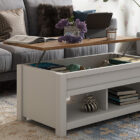What’s a better choice of material to design sturdy furniture – MDF board or plywood? Let us find out.
Medium Density Fiberboard (MDF) and plywood are an integral part of home interiors as they are used as a base to build kitchen units or modular furniture like beds, TV units or wardrobes. While the usage of both these materials is equally essential they each come with their set of advantages and disadvantages. But which one is the best? Considering how important these materials are to design sturdy and durable modular furniture we thought we’ll answer this question for you.
So before we decide which one is better, MDF or plywood, let’s learn about each of them in detail.
What Is MDF?
MDF is built as a single plank that is produced by binding together multiple fibres of the wood. It is a common type of engineered wood, has a smooth texture to it and offers an excellent finish when paired with a suitable laminate. MDF is more economical than plywood, however, it is not as hard and can bend under heavy-weight. Besides, it doesn’t handle moisture very well. Therefore it is a better choice to use indoors for furniture pieces or modules.

Now that we know how MDF is produced, let’s explore its advantages and disadvantages:
Also Read: What is MDF Material? Everything You Need to Know
Advantages Of MDF:
- More affordable than plywood
- Has a smooth surface that makes it easy to paint on
- It is uniform throughout, hence cut edges look smooth and won’t have bits or splinters
- Can be used to design decorative edges with the help of a router
- The smooth texture and consistency of MDF allow for effortless cutting of intricate designs (for instance scalloped or scrolled designs) by using a band saw, scroll saw, or jigsaw
Disadvantages Of MDF:
- MDF soaks up moisture, water and other liquids just like a sponge; it bends and swells unless it’s sealed perfectly from all the edges and sides
- As it is made of such fine particles, it’s difficult to screw nails into MDF perfectly
- It is thick and heavy making it more challenging to work with
- Besides soaking up water, it also soaks up stains as there’s no wood grain on MDF
- It comprises volatile organic compounds (e.g. urea-formaldehyde) and therefore care must be taken while trimming and sanding to avoid inhaling the fine particles
What Is Plywood?
Plywoods have become a popular choice of material when it comes to designing modular kitchens over the last few decades. It is produced from a specific type of wood panel that is manufactured after being processed. Its surface is laminated and polished that gives it an excellent finish. Just like MDF, plywood is available in varying thicknesses and grades for you to choose the best one for your home. Lower-grade plywoods are used in the creation of homes and their interiors. The higher-grade plywood such as cabinet and stain grade is much better-looking and smoother.

Let’s explore its advantages and disadvantages.
Advantages Of Plywood
- Engineered from multiple layers of wood veneer
- Plywood is a solid material to use and work with
- It doesn’t soak up water and liquids as quickly as MDF, therefore, it’s less sensitive to water damage
- As it is produced with a grain, plywood does not stain, making it an excellent for kitchen cabinets designs, beds and tabletops
- It’s easy to drill screws effortlessly and tightly as the different grains of wood on every layer provide a strong base for it
Disadvantages Of Plywood
- It is a little costlier than MDF and the cost majorly depends upon the grade of plywood and on the varieties of wood
- It requires finishing with the process of iron-on edge banding because of the multiple layers that are visible on the edge
- It’s tougher to obtain a flawless, smooth cut with plywood as compared to MDF
- It’s more challenging to cut intricate designs into plywood as the edges splinter easily and the sides that expose layers may have gaps in certain places.
So Which Is Better? MDF Or Plywood?
The answer depends on where you use each of them! For instance, MDF is not resistant to moisture, water or other liquids. This means it is not recommended to use indoors on furniture.. Also, because of its non-directional grain structure, MDF is perfect for cutting and drilling without leaving chips and splinters. The smooth surface of MDF makes it the right pick for basic pieces that need a coat of fresh paint like kitchen cabinets, shelves, frames and the like.
Plywood, on the other hand, is commonly used for stairs, beds, doors, hardwood flooring and home exterior designs. However, it bends easily because of the grain and therefore it is commonly used to design curved surfaces… Water and moisture further affect the durability of plywood. Exterior-glued plywood sheets can be used for the pieces used outside. However, it works well if the moisture level remains low.
Also, check out
 Select Category
Select Category 












